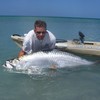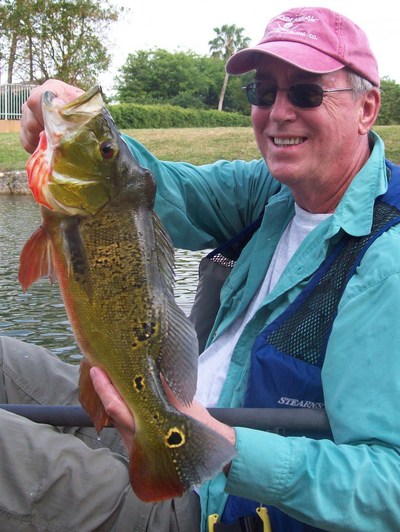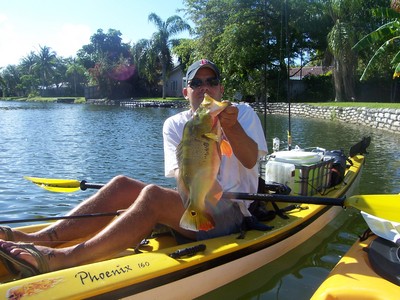WHY ARE PEACOCK BASS IN FLORIDA
The Butterfly Peacock, or Peacock Bass, was introduced into the urban canals of southeast Florida by the FWC during the mid-1980's to control the spread of illegally introduced non-native fish species. Between the years of 1984 and 1987 fisheries scientists from the FWC released 20,000 Butterfly Peacock fingerlings into the major canal systems of southeast Florida. Since then no further fish have been released into the system and the original release of fish has produced a flourishing, breeding population within the urban Miami - Ft. Lauderdale area. The experiment was a complete success by all accounts. Since their introduction, Peacock Bass have helped control the populations of non-native species, not competed with native fish for forage food, and created a multi-million dollar a year sport fishery.
Because of their rigid temperature requirements, and inability to tolerate salinity levels above the normal threshold of the native Largemouth Bass, the spread of Butterfly Peacocks has been restricted to the southeast Florida area. Butterfly Peacocks cannot tolerate temperatures below 60F and the warmer water that flows from the Biscayne Aquifer into these urban canals and surrounding areas, allows the fish to survive the colder months when occasionally water temperatures do dip into lethal temperatures. While occasionally mild fish kills do occur, usually in the northern most areas of its range, the Peacock Bass have successfully survived and spawned since their introduction. Butterfly Peacocks are currently established in the freshwaters ranging from southern Palm Beach County southward through Dade County and the Miami area.
WHERE TO FIND PEACOCK BASS
Peacock Bass are extremely abundant throughout southeast Florida, especially within the urban canal systems that extend southward from southern Palm Beach County through the Miami-Dade area. While rigid temperature requirements have kept them mostly restricted in these areas Peacock Bass can also be encountered from time to time within the Everglades Canal System. When looking for productive areas it is best to concentrate on shaded areas provided by overhanging trees or bridges, as well as fallen trees, canal intersections, culverts, and canal ends. In times of heavy current, which occurs in the canal system after heavy rains, it is best to focus more heavily on offshoot canals, bends, and dead ends that offer a break from the main canal current and allow Peacocks to ambush forage fish being swept by.
Peacock Bass are abundant throughout the year in southeast Florida, but the best time to catch larger Peacocks ranging from 5# to 9# (with the chance for a larger fish a definite possibility) is from February through May when the fish are spawning. During this period sight fishing opportunities are at their best allowing anglers to slowly maneuver along the canal systems, making casts at pairs of fish along the canal edges. This is a fantastic opportunity for fly fisherman to successfully target Butterfly Peacocks.
Unlike the popular Largemouth Bass which also inhabits these areas, the Peacock Bass doesn't feed at night or in low light conditions. Instead, they prefer to feed in broad daylight.
BAITS AND TACKLE FOR PEACOCK BASS
When rigging for Peacock Bass you don't need to bring the heavy tackle. The urban canals in which they live are open and free of any obstruction for the most part. This allows anglers targeting Butterfly Peacocks to use medium to medium light power spinning outfits with 6 to 8 pound monofilament line and a short length of 15# fluorocarbon leader. If fishing with live bait a small #2 or #4 live bait hook is attached to the end of the leader and no weight is used.
The best bait by far for Butterfly Peacocks is undeniably a small live shiner. Live shiners produce more Butterfly Peacocks than any other bait, and are more preferable for novice anglers because of their ease of use. To use a live shiner, simply hook it through the nose and free-line it into areas most likely to hold fish. Another proven tactic is to slowly troll a live shiner behind the boat as close to the canal walls and structure as possible. This is especially productive when covering a lot of water looking for actively feeding fish.
When it comes to artificial baits Peacock Bass will hit just about any baits used to target Largemouth Bass, with one glaring exception - Peacock Bass do not hit plastic worms. Top water baits such as the Heddon Torpedo are great for targeting active Peacocks. Cast top water baits into areas where Peacocks are seen actively feeding on the surface for some fast action. Other popular artificial baits include minnow imitating crank baits, Rat-L-Traps, Yozuri Crystal and Pins Minnows, Floating Rapalas and Shad Raps. Working these baits very quickly through likely areas is a very productive method of taking Peacocks throughout the year. Also, quickly trolling floating gold Rapalas through the middle of canals is a favorite technique of many local guides for targeting schooling Peacocks during cooler months.
PEACOCK BASS FACTS
The Peacock Bass is not a Bass at all but rather a member of the Cichlid family. The Peacock got the name Bass because of its resemblance to the Largemouth Bass (not a true Bass either) in shape.
The Peacock Bass is native to the Amazon River Basin of South America.
The Peacock Bass established in the southeast Florida area do not reach the huge size of their South American relatives. The average catch is between 1 and 4 pounds with the maximum size around 12 pounds.
PEACOCK BASS REGULATIONS
The current limit on Peacock Bass in Florida is two per angler per day with only one fish being larger than 17 inches. Anglers are encouraged to practice catch and release to ensure the longevity of the fishery.




